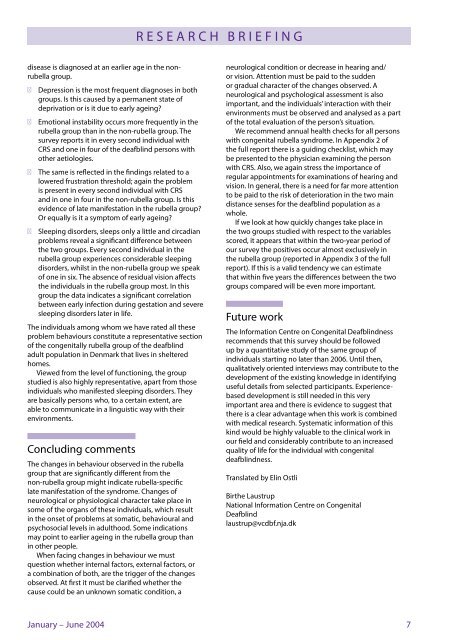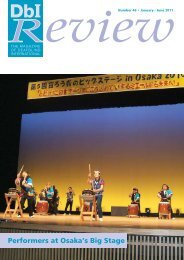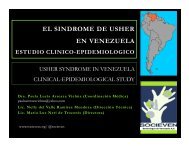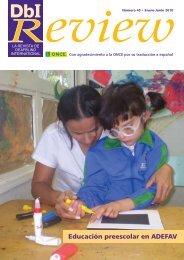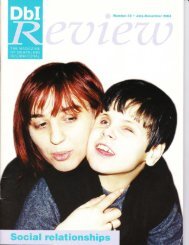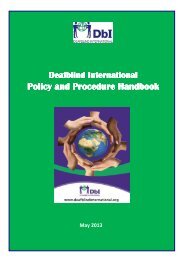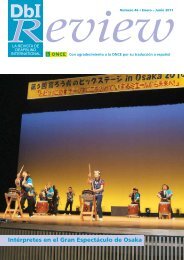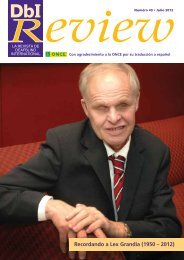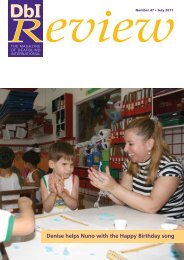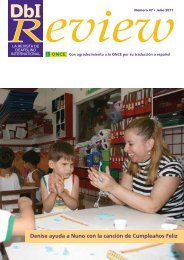Families in Nepal - Deafblind International
Families in Nepal - Deafblind International
Families in Nepal - Deafblind International
You also want an ePaper? Increase the reach of your titles
YUMPU automatically turns print PDFs into web optimized ePapers that Google loves.
esearch brief<strong>in</strong>gdisease is diagnosed at an earlier age <strong>in</strong> the nonrubellagroup. Depression is the most frequent diagnoses <strong>in</strong> bothgroups. Is this caused by a permanent state ofdeprivation or is it due to early age<strong>in</strong>g?Emotional <strong>in</strong>stability occurs more frequently <strong>in</strong> therubella group than <strong>in</strong> the non-rubella group. Thesurvey reports it <strong>in</strong> every second <strong>in</strong>dividual withCRS and one <strong>in</strong> four of the deafbl<strong>in</strong>d persons withother aetiologies.The same is reflected <strong>in</strong> the f<strong>in</strong>d<strong>in</strong>gs related to alowered frustration threshold; aga<strong>in</strong> the problemis present <strong>in</strong> every second <strong>in</strong>dividual with CRSand <strong>in</strong> one <strong>in</strong> four <strong>in</strong> the non-rubella group. Is thisevidence of late manifestation <strong>in</strong> the rubella group?Or equally is it a symptom of early age<strong>in</strong>g?Sleep<strong>in</strong>g disorders, sleeps only a little and circadianproblems reveal a significant difference betweenthe two groups. Every second <strong>in</strong>dividual <strong>in</strong> therubella group experiences considerable sleep<strong>in</strong>gdisorders, whilst <strong>in</strong> the non-rubella group we speakof one <strong>in</strong> six. The absence of residual vision affectsthe <strong>in</strong>dividuals <strong>in</strong> the rubella group most. In thisgroup the data <strong>in</strong>dicates a significant correlationbetween early <strong>in</strong>fection dur<strong>in</strong>g gestation and severesleep<strong>in</strong>g disorders later <strong>in</strong> life.The <strong>in</strong>dividuals among whom we have rated all theseproblem behaviours constitute a representative sectionof the congenitally rubella group of the deafbl<strong>in</strong>dadult population <strong>in</strong> Denmark that lives <strong>in</strong> shelteredhomes.Viewed from the level of function<strong>in</strong>g, the groupstudied is also highly representative, apart from those<strong>in</strong>dividuals who manifested sleep<strong>in</strong>g disorders. Theyare basically persons who, to a certa<strong>in</strong> extent, areable to communicate <strong>in</strong> a l<strong>in</strong>guistic way with theirenvironments.Conclud<strong>in</strong>g commentsThe changes <strong>in</strong> behaviour observed <strong>in</strong> the rubellagroup that are significantly different from thenon-rubella group might <strong>in</strong>dicate rubella-specificlate manifestation of the syndrome. Changes ofneurological or physiological character take place <strong>in</strong>some of the organs of these <strong>in</strong>dividuals, which result<strong>in</strong> the onset of problems at somatic, behavioural andpsychosocial levels <strong>in</strong> adulthood. Some <strong>in</strong>dicationsmay po<strong>in</strong>t to earlier age<strong>in</strong>g <strong>in</strong> the rubella group than<strong>in</strong> other people.When fac<strong>in</strong>g changes <strong>in</strong> behaviour we mustquestion whether <strong>in</strong>ternal factors, external factors, ora comb<strong>in</strong>ation of both, are the trigger of the changesobserved. At first it must be clarified whether thecause could be an unknown somatic condition, aneurological condition or decrease <strong>in</strong> hear<strong>in</strong>g and/or vision. Attention must be paid to the suddenor gradual character of the changes observed. Aneurological and psychological assessment is alsoimportant, and the <strong>in</strong>dividuals’ <strong>in</strong>teraction with theirenvironments must be observed and analysed as a partof the total evaluation of the person’s situation.We recommend annual health checks for all personswith congenital rubella syndrome. In Appendix 2 ofthe full report there is a guid<strong>in</strong>g checklist, which maybe presented to the physician exam<strong>in</strong><strong>in</strong>g the personwith CRS. Also, we aga<strong>in</strong> stress the importance ofregular appo<strong>in</strong>tments for exam<strong>in</strong>ations of hear<strong>in</strong>g andvision. In general, there is a need for far more attentionto be paid to the risk of deterioration <strong>in</strong> the two ma<strong>in</strong>distance senses for the deafbl<strong>in</strong>d population as awhole.If we look at how quickly changes take place <strong>in</strong>the two groups studied with respect to the variablesscored, it appears that with<strong>in</strong> the two-year period ofour survey the positives occur almost exclusively <strong>in</strong>the rubella group (reported <strong>in</strong> Appendix 3 of the fullreport). If this is a valid tendency we can estimatethat with<strong>in</strong> five years the differences between the twogroups compared will be even more important.Future workThe Information Centre on Congenital Deafbl<strong>in</strong>dnessrecommends that this survey should be followedup by a quantitative study of the same group of<strong>in</strong>dividuals start<strong>in</strong>g no later than 2006. Until then,qualitatively oriented <strong>in</strong>terviews may contribute to thedevelopment of the exist<strong>in</strong>g knowledge <strong>in</strong> identify<strong>in</strong>guseful details from selected participants. Experiencebaseddevelopment is still needed <strong>in</strong> this veryimportant area and there is evidence to suggest thatthere is a clear advantage when this work is comb<strong>in</strong>edwith medical research. Systematic <strong>in</strong>formation of thisk<strong>in</strong>d would be highly valuable to the cl<strong>in</strong>ical work <strong>in</strong>our field and considerably contribute to an <strong>in</strong>creasedquality of life for the <strong>in</strong>dividual with congenitaldeafbl<strong>in</strong>dness.Translated by El<strong>in</strong> OstliBirthe LaustrupNational Information Centre on CongenitalDeafbl<strong>in</strong>dlaustrup@vcdbf.nja.dkJanuary – June 2004 7


